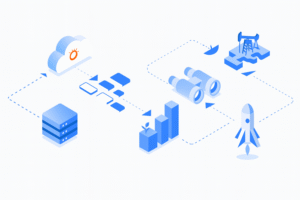In today’s data-driven world, information is king. But with vast amounts of data at our fingertips, the challenge lies not in acquiring it, but in extracting actionable insights. This is where AI-powered analytics steps in, offering a revolutionary approach to decision-making across industries.
The human brain is an amazing organ, but it has limitations when it comes to processing massive amounts of data. We can easily become overwhelmed by information overload, leading to analysis paralysis or snap judgments based on incomplete information. AI, on the other hand, thrives on data. It can churn through enormous datasets, identifying subtle patterns and relationships that would go unnoticed by the human eye. This allows AI to uncover hidden gems of information that can inform and improve decision-making across all levels of an organization.
Why AI for Decision-Making?
Traditional decision-making often relies on intuition, experience, and limited data analysis. While these factors hold value, they can be susceptible to human bias and incomplete information. AI-powered analytics tackles these limitations by:
- Uncovering Hidden Patterns: AI algorithms can sift through massive datasets, identifying subtle patterns and relationships that might escape human analysis. This unveils previously unknown trends and correlations, leading to more informed decisions.
- Enhanced Speed and Scalability: Analyzing vast data sets manually is a time-consuming and laborious task. AI automates this process, allowing for near-instantaneous analysis of complex data, enabling faster and more responsive decision-making.
- Predictive Power: AI can learn from historical data and identify past trends. By applying this knowledge to current situations, AI models can predict future outcomes with greater accuracy. This allows businesses to be proactive and make data-driven decisions that prepare them for what’s ahead.
- Reduced Bias: Human judgment can be influenced by subconscious biases. AI, on the other hand, relies on objective data analysis, minimizing the impact of personal biases and promoting fairer decision-making.
- Continuous Learning: Unlike traditional decision-making models, AI systems continuously learn and improve as they are exposed to new data. This ensures that your decisions are always based on the most up-to-date information.
- Improved Risk Management: AI can analyze vast amounts of data to identify potential risks and assess their likelihood of occurrence. This allows businesses to take proactive measures to mitigate risks and safeguard their operations.
- Streamlined Workflows: AI can automate repetitive tasks associated with data analysis, freeing up human resources to focus on more strategic initiatives.
Putting AI into Action: Real-World Applications
AI-powered analytics isn’t just theoretical; it’s transforming industries in practical ways. Here are a few examples:
- Finance: AI helps financial institutions assess risk, identify fraudulent activity, and personalize investment recommendations for clients.
- Retail: AI can predict customer demand, optimize inventory management, and personalize marketing campaigns for increased sales and customer satisfaction.
- Manufacturing: AI analyzes sensor data from machines to predict maintenance needs, preventing costly downtime and optimizing production processes.
- Healthcare: AI can analyze patient data to personalize treatment plans, identify potential outbreaks of diseases, and accelerate drug discovery.
- Supply Chain Management: AI can optimize logistics networks, predict disruptions, and ensure timely delivery of goods, reducing costs and improving customer satisfaction.
- Human Resources: AI can automate tasks like resume screening and candidate evaluation, freeing up HR professionals to focus on strategic initiatives and employee engagement.
The Human-AI Collaboration: A Winning Partnership
It’s important to remember that AI is not a replacement for human decision-making. Instead, it’s a powerful tool that augments human capabilities. AI excels at data analysis and pattern recognition, while humans bring critical thinking, experience, and the ability to understand the broader context of a situation. The key lies in leveraging the strengths of both to create a winning partnership. Here are seven key reasons why this human-AI collaboration is such a powerful force:
- Domain Expertise + Machine Learning: Humans possess specialized knowledge and experience within their fields. When combined with AI’s ability to learn and adapt from vast datasets, this creates a powerful synergy. AI can process industry-specific data alongside human expertise, leading to more nuanced and accurate decision-making.
- Creativity and Innovation: AI excels at identifying patterns and trends, but it lacks the human capacity for creative problem-solving and out-of-the-box thinking. This is where humans shine. By presenting AI’s data insights alongside human creativity, businesses can foster innovation and develop groundbreaking solutions.
- Ethical Considerations and Moral Compass: AI decision-making algorithms are only as good as the data they’re trained on. Humans play a crucial role in ensuring the ethical implications of AI are considered. Human oversight ensures AI recommendations align with company values and avoid unintended biases.
- Communication and Collaboration: While AI can analyze data and generate insights, it lacks the ability to effectively communicate those findings to stakeholders. Humans can bridge this gap by translating complex data analysis into clear and concise communication, fostering buy-in and collaboration across teams.
- Building Trust and Transparency: For AI-powered decisions to be adopted, there needs to be a foundation of trust and transparency. Humans can explain the rationale behind AI recommendations, building trust and ensuring stakeholders understand the decision-making process.
- Adaptability and Agility: The business landscape is constantly evolving. The human ability to adapt and make quick judgments based on changing circumstances is crucial. By combining AI’s data-driven insights with human agility, businesses can respond more effectively to unforeseen challenges and opportunities.
- Emotional Intelligence and Empathy: Human decision-making considers emotional intelligence and empathy, crucial aspects often missing in AI analysis. Humans can factor in the emotional impact of decisions and tailor approaches to best suit the situation.
In conclusion, the human-AI collaboration is not a competition, but a powerful partnership. By leveraging the unique strengths of both humans and AI, businesses can unlock a new level of decision-making efficiency, innovation, and success.
Nexright: Your Trusted Partner in AI-powered Decision-Making
The future of business is data-driven, and AI-powered analytics is the key to unlocking its full potential. At Nexright, we are passionate about helping businesses harness the power of AI to make smarter decisions, gain a competitive edge, and achieve their strategic goals.
As part of this journey, many forward-thinking enterprises are already embracing AI powered automation reimagining the future of work to streamline operations, improve productivity, and foster innovation across their workforce.
Ready to unlock the power of AI-powered analytics for your business? Contact Nexright today to learn more about our solutions and how we can help you optimize your decision-making and achieve success.




